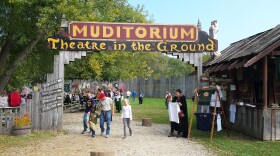If you visit downtown Wilmington, you’ll see large black and white photos of its residents plastered on the sides of buildings. Each person has dirt somewhere on them: on a shirt, or a bicep, or a cheek. In one portrait, an elderly woman has dirt smeared under each eye. She’s holding her fists up to the camera, and “G-R-I-T” is written in all caps across the knuckles of each hand.
Community Voices Producer Jason Reynolds wanted to know what this was all about.
In Wilmington, people are talking about the huge photos that starting popping up a few weeks ago. There are dozens of them, and they’re everywhere.
Darrell Tucker, a deliveryman for the Wilmington News Journal, tells me that he first saw them while making his morning rounds. “I was like, ‘Man! What is that?,’” Tucker says. He says he likes them, too. “I don’t know what GRIT stands for, but looking at these people—some of them are from this town. I’ve seen them.”

Tattoo artist Kenny Wilson knows people in the photographs, too. He points at portraits and tells me about his neighbors: “The second guy [on the wall], he was in the military and lost both of his legs. And Becca, we know her personally. She lost family members. I know that. She comes in, and she gets tattooed here.”
Then there’s middle school art teacher Jane Taylor. Some of her students’ faces are on the walls. She tells me the project is called Wilmington’s got GRIT, and that “Grit is, in the educational world, someone who has perseverance and tenacity, and even though they cannot easily achieve their idea or goal, they keep going and going until they absolutely achieve it.”
Taylor tells me to go around the corner, to the Murphy Theater, where there’s a reception for the project. That’s where I meet Doug Davis, the grade school art teacher who helped make this happen. It all started when Davis watched a TED Talk by JR, an international artist whose Inside Out Project has put large photos outdoors in 129 countries.

“My principal, Karen Long, was kind of throwing around this term called Grit,” Davis says. “And I said, ‘Mrs. Long, you should check this out. Wouldn’t this be great if we did this for our school?’ And we were tossing this around and we were thinking about Grit and, well, that’s the story of Wilmington.”
Here, some backstory may be necessary: In 2009, European shipping giant DHL left Wilmington’s Air Park, taking 8,000 jobs out of a community of 12,000 people. Wilmington became the poster-town for the great recession. Small business shut. Homes were foreclosed. And media outlets kept using Wilmington as an example of just how bad it could get. But for Wilmington residents, that’s not the story. It’s just where the story begins.
“We felt like there was so much negative publicity that was happening with Wilmington,” Davis says, “and the people never left. They stayed here. They may have traveled out. They may have commuted long distances and retrained for jobs, but they’re still here, and we’re highlighting that tenacity and grit of our community. That’s the story that we are celebrating.”
And putting photos of residents all over town builds respect and appreciation. Karen Long, the principle at Davis’ school, says “you’re able to see someone’s face—and most people recognize the people on our walls—but we may not recognize that they were going through a challenge or a hardship and that they were using grit to get through a day or a time in their life. So, you look at these pictures of ordinary people and you wonder what their grit story is.”
At the reception, you can see how the project is expanding. There’s a photo booth where residents can have their pictures taken and added to the project. And WALH, Wilmington’s community radio station, is open for residents who want to record their Grit Stories.

Wilmington resident Derrick Jones has a story, too.
“You know, it was a struggle for me as well,” he says, “because I had to find work out of town as well. I had to travel to Kettering, Beavercreek, and also Xenia. But now I’m actually back here. I’m working at Clinton Memorial Hospital, so I actually found my way back to my community.”
Much of the talk at the Murphy Theater is about the educational programs that helped the city recreate itself. One program gave high school graduates grants to attend the local community college, and the four-year college in Wilmington created programs that forgave loans when students stayed in Wilmington after graduation. There was even a program to give first time home buyers $2,500 if they bought in Wilmington.
It seems to be working. In October, President Obama wrote an op-ed in which he noted that the majority of Wilmington’s city council was millennials. It’s also notable that online giant Amazon has moved some shipping operations into the airpark DHL left behind. Pepsi and Polaris have moved in, too.
All of this is cause for cautious optimism in a gritty city.
This film about Wilmington's Got GRIT that was produced by Wilmington resident Grant Peele, who has a project called Celebrate Wilmington. You can see other works and contact him at https://www.facebook.com/






